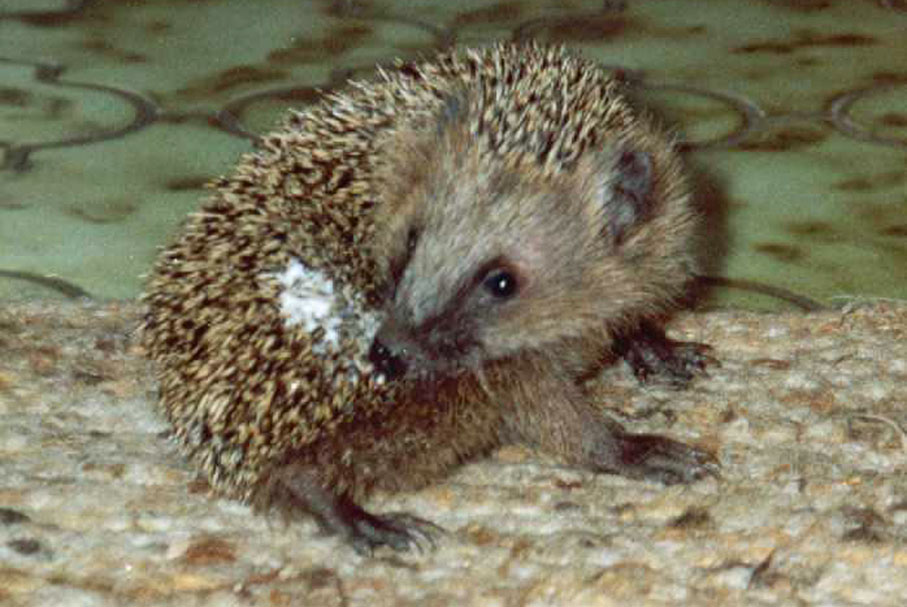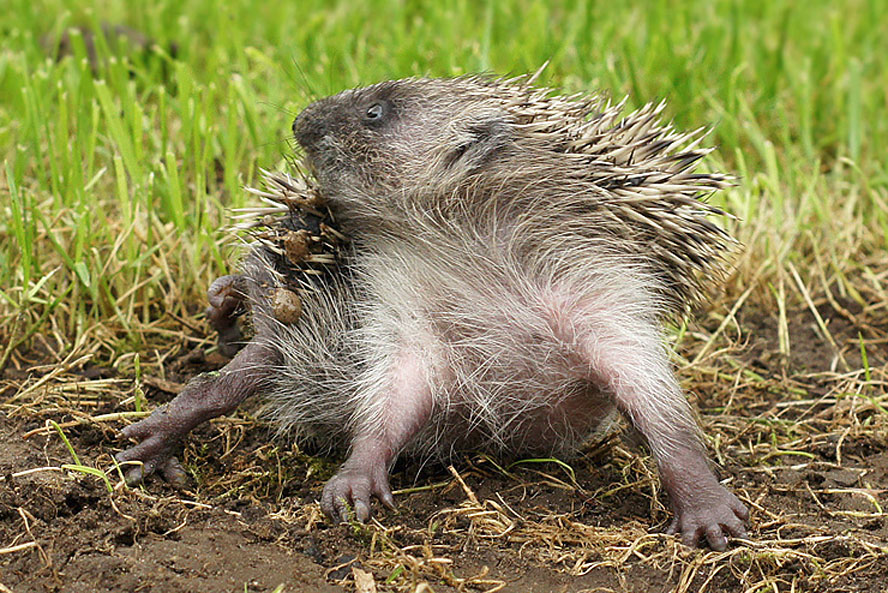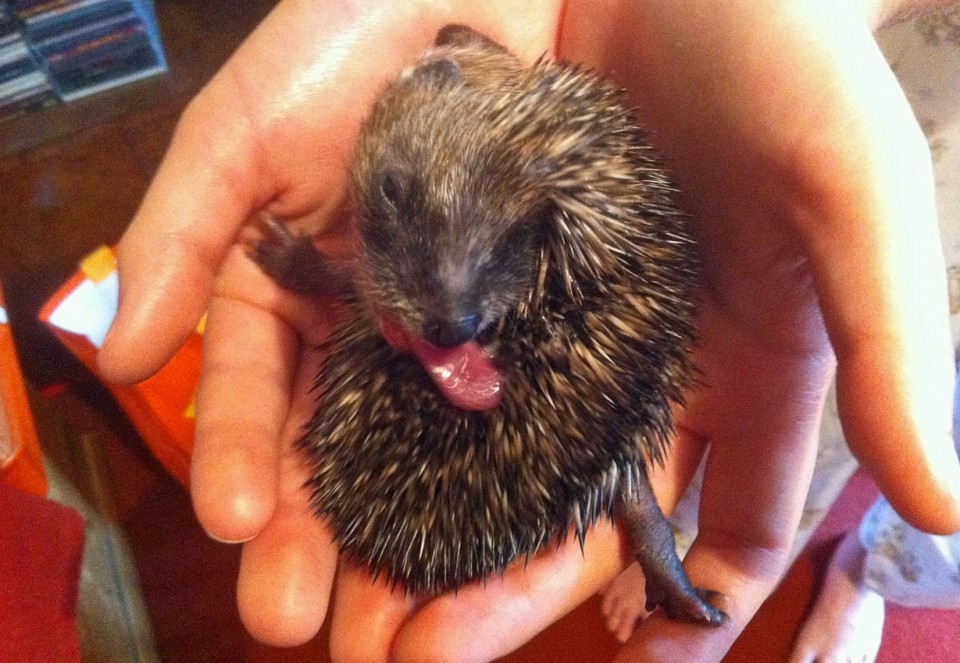European Hedgehog Behaviour - Self-Anointing
Perhaps one of the most bizarre facets of hedgehog behaviour is the curious act of self-anointing. The term was coined by Maurice Burton in an account of the behaviour published in New Scientist in October 1958, but was first recorded by German zoologist Ludwig Heck in 1912; he called it selbstbespuchen, or ‘self-spitting’.
Self-anointing involves the hedgehog covering its spines with a frothy saliva-stimulant mixture; the behaviour itself may take a few minutes or several hours, during which the hedgehog is totally absorbed and almost oblivious to the activity in its surroundings. This behaviour is reported frequently, and most people who have experience with hedgehogs have witnessed it at some point. Nigel Reeve describes the process in Hedgehogs. When a hog encounters a stimulating object or substance, it is sniffed, licked and then chewed – the trigger object may be taken into the mouth, but sometimes the odour alone is sufficient to trigger anointing. The resulting saliva is applied to the spines and fur with the underside of the tongue as the hedgehog contorts its body and licks itself.
There have been numerous theories proposed to explain the purpose of this bizarre behaviour, although, as we'll see shortly, none fits all cases. Indeed, we currently don't even understand what initiates this behaviour in the first place. Hedgehogs can be stimulated by the same substance on successive occasions, while objects that stimulate self-anointing on one occasion may not do so on another, illustrating how the behaviour is very individual-specific.
The list of objects/substances recorded as inducing self-anointing is quite remarkable, not to mention extensive. In Hedgehogs, Nigel Reeve lists 34, including fox fur, human sweat, carpet, varnish, creosote, tobacco, newsprint and even tortoises! The most oft-cited suggestion tends to be that trigger objects have smells or tastes that can be considered pungent or acrid. This is certainly true in some cases (e.g. polish, glues, human feet, dog urine and faeces. etc.), but certainly not in all. Innocuous (to our senses, at least) objects and substances, such as glass or cotton, can elicit self-anointing and, in his 1969 book The Hedgehog, Maurice Burton notes how hedgehogs have been known to anoint when presented with distilled water, which has no smell or taste. I've seen the behaviour triggered by rain water in our drinking station and an empty plastic bowl. Furthermore, some pungent and/or acrid substances don’t appear to induce the behaviour - petrol, vinegar and whisky, for example. An alternative theory is that the substance is novel to the hog, but again, this doesn't appear to hold up to scrutiny. I've seen hedgehogs self-anoint after chewing grass or having randomly start licking the side of a hedgehog house they've been in and out of for several days. Likewise, a reader contacted me recently describing a well-grown hoglet that stopped midway through suckling to self-anoint the milk.

The circumstances in which self-anointing occurs are similarly broad. Originally thought to occur only during the rut, Nigel Reeve found evidence of anointing outside of the breeding season in his golf course subjects and this phenomenon has since been reported in both sexes, when solitary, when meeting and in all ages, even still-blind nestlings. Indeed, in a short paper to the International Zoo Yearbook in 1966, Bryn Morris described how a nine-day-old hoglet was observed self-anointing, apparently stimulated by the resin on the sides of the heated box they were being kept in at the University of Nottingham’s zoology department.
Despite the foregoing, some studies have suggested patterns in the behaviour. In a 2005 paper to the journal Acta Theriologica, a team of biologists at the University of Antwerp led by Helga D'Have reported that self-anointing was "clearly dependent on gender, age and season." During 2002, the scientists recorded the occurrence of self-anointing among nearly 200 tagged hedgehogs from several populations at five study sites in Belgium. Incidence among the hedgehogs was relatively low, with only 46 (11%) showing signs of self-anointing. (This figure may appear higher than most other studies, which observed the behaviour in less than 2% of animals, but these researchers recorded both recent and 'trace' self-anointing, while other authors only monitored recent activity – when the trace evidence is removed, the data show self-anointing in seven animals; about 2%).
The data from the Belgian study show that males tended to self-anoint more than females, with subadult males anointing most; young males accounted for 35% of observations, young females 18%, adult males 8%, and adult females 4%. There was a peak of self-anointing observed during the summer, with almost 40% of the adults and about 15% of the juveniles found with evidence of self-anointing in July. Observed self-anointing declined in August (about 12% adults and 8% juveniles) and then increased among adults during September (around 35%).
The data collected by D'Have and her colleagues cast doubt upon the theory proposed by Robert Brockie based on his observations of self-anointing by wild hedgehogs in New Zealand. In his 1976 paper to Animal Behaviour, Brockie suggested that, because he only found saliva-covered spines on individuals during the courtship season, self-anointing may be a way of presenting sexual odour. The Belgian data showed a peak of anointing in July, while a great deal of courtship takes place in April and May, suggesting the behaviour isn't related to, or at least isn't a necessary part of, sexual signalling between hedgehogs. So, if it doesn't appear to be breeding-related, what might lie at the root of this intriguing activity? At the time of writing, there are five main schools of thought on why hedgehogs self-anoint.
The first theory (the so-called "camouflage hypothesis") suggests that covering the spines with a foreign substance may serve to mask the hedgehog’s odour, thereby perhaps imparting some anti-predator or anti-conspecific quality, remembering both that males can be highly aggressive and that hedgehogs have a good sense of smell. Indeed, from their results, D'Have and her team suggest that the camouflage hypothesis may explain the self-anointing patterns that they observed. The biologists noted that juveniles self-anointed more than adults and that this could be a bid to provide extra protection from predators at their most vulnerable life stage. Similarly, as we have seen, adult males range further than adult females and this may explain their higher self-anointing frequencies – ranging further means you're more likely to encounter both predators and other males. To the best of my knowledge, there no studies looking at whether self-anointing does make hedgehogs less prone to being detected either by conspecifics or predators, but many of the substances that induce this behaviour would not be efficient in repelling the latter. Similarly, it fails to address the presence of the behaviour in females, unless they use it when they want to avoid unwanted male attention. Nevertheless, despite some gaps, this theory has merit and I am certainly of the opinion that hedgehogs rely on scent to detect mates and competitors (sometimes at reasonable distance) more than has previously been recognised.
It has also been advanced that the saliva and its trigger compound(s) may serve a grooming purpose, conditioning the skin and spines or perhaps killing parasites, although the latter would presumably require some form of ‘toxic saliva’. According to a paper to Toxicon in 1999 by Dietrich Mebs, extracts from the Glandula submandibularis and Glandula parotis salivary glands of Erinaceus europaeus yielded no lethal, haemorrhagic or myonecrotic (heart damaging) effects when injected into mice – this certainly implies that hedgehogs, unlike other insectivorous mammals (e.g. shrews), do not have toxic saliva.

Supplemental to the 'toxic saliva' theory, Nigel Reeve found a hedgehog that had anointed its spines with dog faeces, which is an unlikely skin or hair conditioner. Additionally, hedgehogs are impressively flexible and perfectly capable of grooming themselves, they often simply seem largely uninterested in doing so. Similarly, there's no indication that self-anointing activity is directed towards exoparasites such as ticks, which can be quite numerous on hedgehogs. Overall, there is no evidence to suggest that the spines need conditioning in order to remain supple, not least because they’re constantly replaced, nor that the self-anointing affects parasite burden or skin condition.
A third theory proposes that the substances applied to the spines may add an extra ‘irritation factor’ to the spines, causing chemical trauma to any would-be predator. A rather famous experiment by Edmund Brodie Jr., published in Nature during 1977, demonstrated that African hedgehog (Atelerix) spines covered with cane toad (Bufo marinus) skin secretions (both manually applied and applied through self-anointing) caused immediate and intense local burning when jabbed into the arms of volunteers; “splotchy red areas” developed around the puncture site. Spines that had been washed in alcohol or coated with ordinary (i.e. non-anointed) hedgehog saliva caused no such reaction, suggesting it was the toad's skin secretion that caused the irritation. While this may demonstrate a plausible explanation for self-anointing, any anti-predator effect is probably coincidental; it is difficult to imagine that spines anointed with saliva generated in response to more innocuous substances (e.g. carpets, tortoises, glass etc.) would prove to be an irritant, given that the saliva itself isn’t toxic.

The fourth theory suggests that self-anointing may be a non-adaptive behaviour. In other words, self-anointing is an aberrant activity that hasn’t evolved to increase the likelihood of survival. This may be the case, although hedgehogs often spend a substantial period of time self-anointing and appear thoroughly self absorbed during it, which is rare for a non-adaptive behaviour. Some non-adaptive suggestions include that the saliva serves to cool the spines or is just a by-product. Off-hand, thermoregulation doesn’t seem a likely explanation; were this the case we’d expect the saliva to be applied directly to the skin because there is no blood flow through the spines. Furthermore, hedgehogs are quite poorly insulated and lose heat rapidly without any assistance. In The Hedgehog, Maurice Burton suggests that licking may be a non-functional response to a stimulus (smell or taste) and the saliva is merely an annoyance that is wiped off onto the spines. This seems plausible, although it is curious that the saliva is always wiped onto the spines; never on the ground or on surrounding objects, and the hedgehog never uses its paws to wipe it away, which would seem quicker and easier. Similarly, the animal frequently contorts its body to anoint spines on its back or rump, rather than using those on its flanks that could be reached with less effort.
The fifth theory, and the one that seems to have garnered the most support, is that self-anointing plays a role in scent-marking that we've yet to understand, perhaps involving the vomeronasal organ. There is little doubt that the spines act as a large evaporative surface for any scent and I think this could link with the ‘mutual avoidance’ of conspecifics discussed above. It may be that the characteristic tongue flicking against the roof of the mouth helps clear the froth from the nasopalatine duct, which leads to the vomeronasal organ.
Supplementary to the five theories above, I have recently started to wonder if this behaviour is some form of "scent management" and there are two examples in particular that have triggered this suggestion: one that posed the question of whether self-anointing is a response of some individuals to a new or unfamiliar location and the second whether it allows for a "family smell" that helps mothers recognise their hoglets.
In March 2020, we released two rehabilitated female hedgehogs into our garden. One (“Terri”) was rescued by us as a sickly youngster the previous autumn and the other (“Winni”) was rescued, also as a juvenile last autumn, by someone else a few miles away who couldn’t take her back. Both were released into the garden together and while Terri disappeared into the border shrubs for the rest of the night, Winni spent almost an hour walking around sniffing and self-anointing; she was also caught later the same night on one of our trailcams self-anointing having licked the camera. It’s obviously impossible to draw any conclusions from a single observation of only two individuals on one night; but it leads me to wonder whether some hogs use self-anointing as a mechanism to help familiarise themselves with their environment. If some animals take longer to acclimate than others, this perhaps accounts for the variation in the frequency with which a given object can trigger the response.
The second example was a report I received from a reader describing how a well-grown hoglet broke off suckling from its mother and self-anointed the milk. The lady asked if this was some form of bonding behaviour. While I don’t believe it is specifically a way for hoglets to bond with their mother, from whom they’ll soon separate, I do question whether the behaviour might allow for all hoglets in a nest to have the same “family smell”. By self-anointing on novel objects in their nest, the hoglets may take on the smell of the nest and this family scent might help the mother keep track of her offspring when they start venturing outside together. If so, the behaviour may be so deeply innate in hedgehogs that it’s exhibition by adults is actually paedomorphic; a “spill over” from childhood, just as we may carry some immature behaviours into adulthood. It might also help comfort them when they encounter an unfamiliar situation.
Whether any of the aforementioned theories do actually represent a true explanation of this peculiar behaviour remains to be seen, but it seems clear that it must serve some adaptive function or have done so in the past. Hedgehogs are entirely absorbed during anointing, making them vulnerable to predators. Furthermore, when they’ve finished they are sometimes dazed, tired and hungry, suggesting it can be an energy expensive behaviour. It should be remembered, however, that modern hedgehogs have been around for the last 20 million year, or so, and it is possible that self-anointing served some important purpose that is now secreted in their ancestry.
It is worth mentioning quickly that self-anointing is not unique to hedgehogs, although it has been found in all hedgehog genera. In 1995, Zhongjian Xu, Hanbo Ding and Jian Zhang at the Fujian Normal University in China and Michael Stoddart at the University of Tasmania in Australia, published a paper in the Journal of Mammalogy describing self-anointing behaviour in the rice-field rat (Rattus rattoides) upon presentation with weasel scent. Additionally, a paper to the journal Primates by Matthias Laska, Verena Bauer and Laura Salazar reports how spider monkeys (Ateles geoffroyi) have been observed to self-anoint in the presence of three species of plant (Brongniartia alamosana, Cecropia obtusifolia and Apium graveolens) – the biologists concluded that the scent of the plants is used in a social context. Other species known to self-anoint include capuchin monkeys (Cebus spp.), owl monkeys (Aotus spp.) and Siberian chipmunks (Eutamias sibiricus).